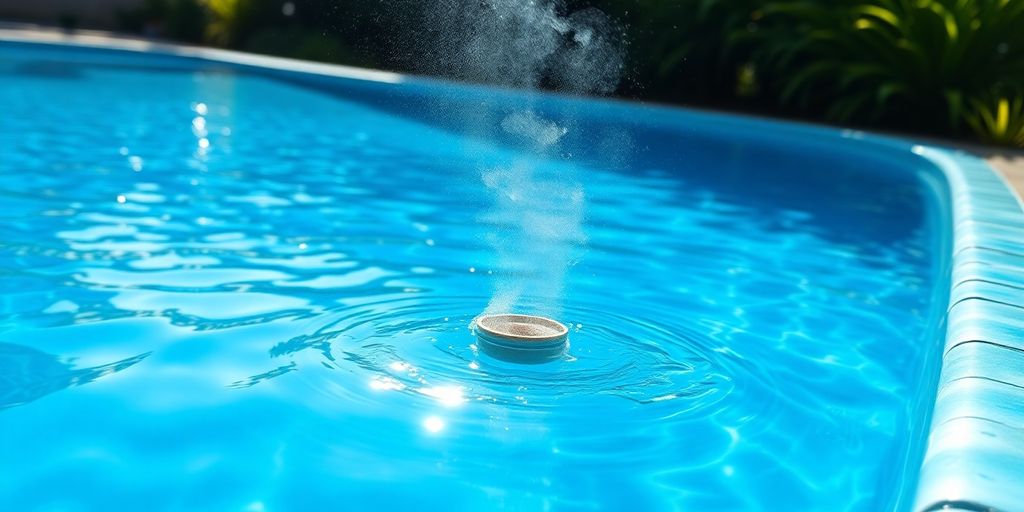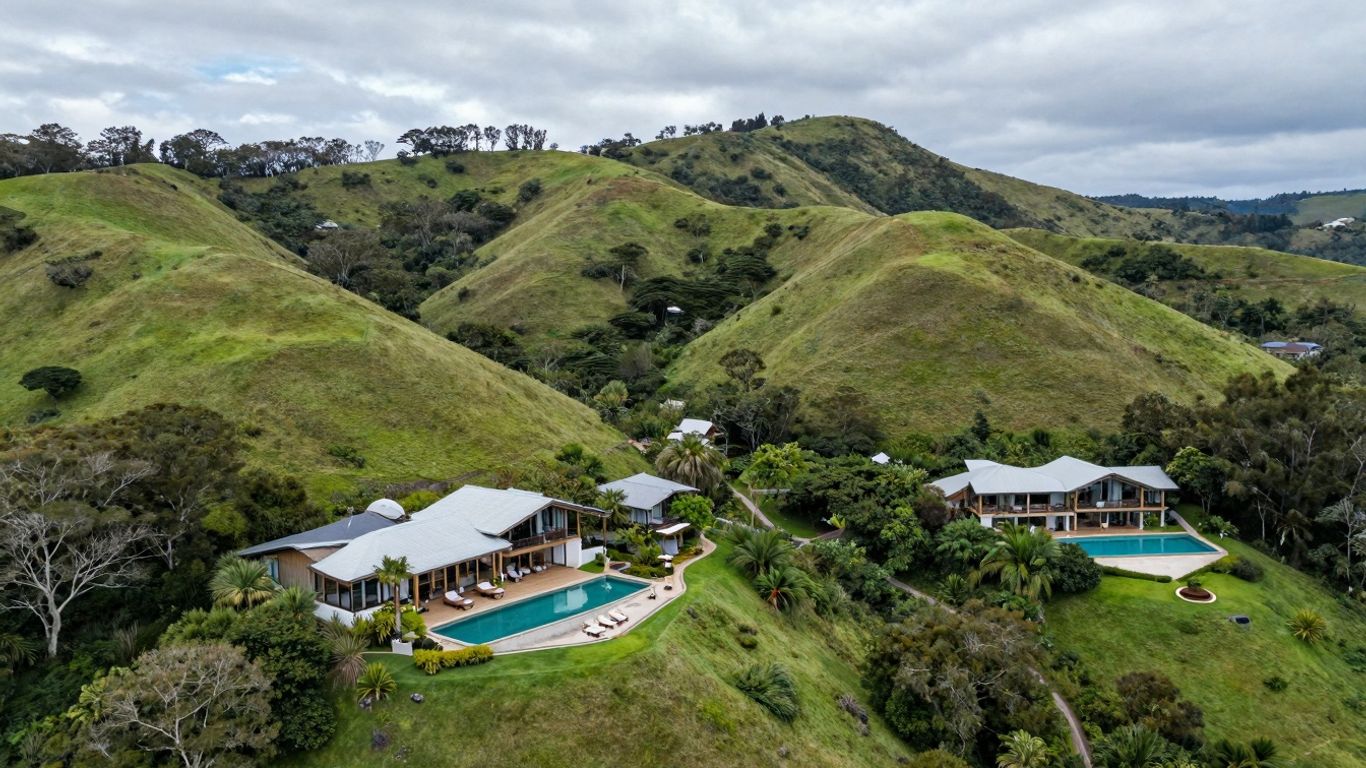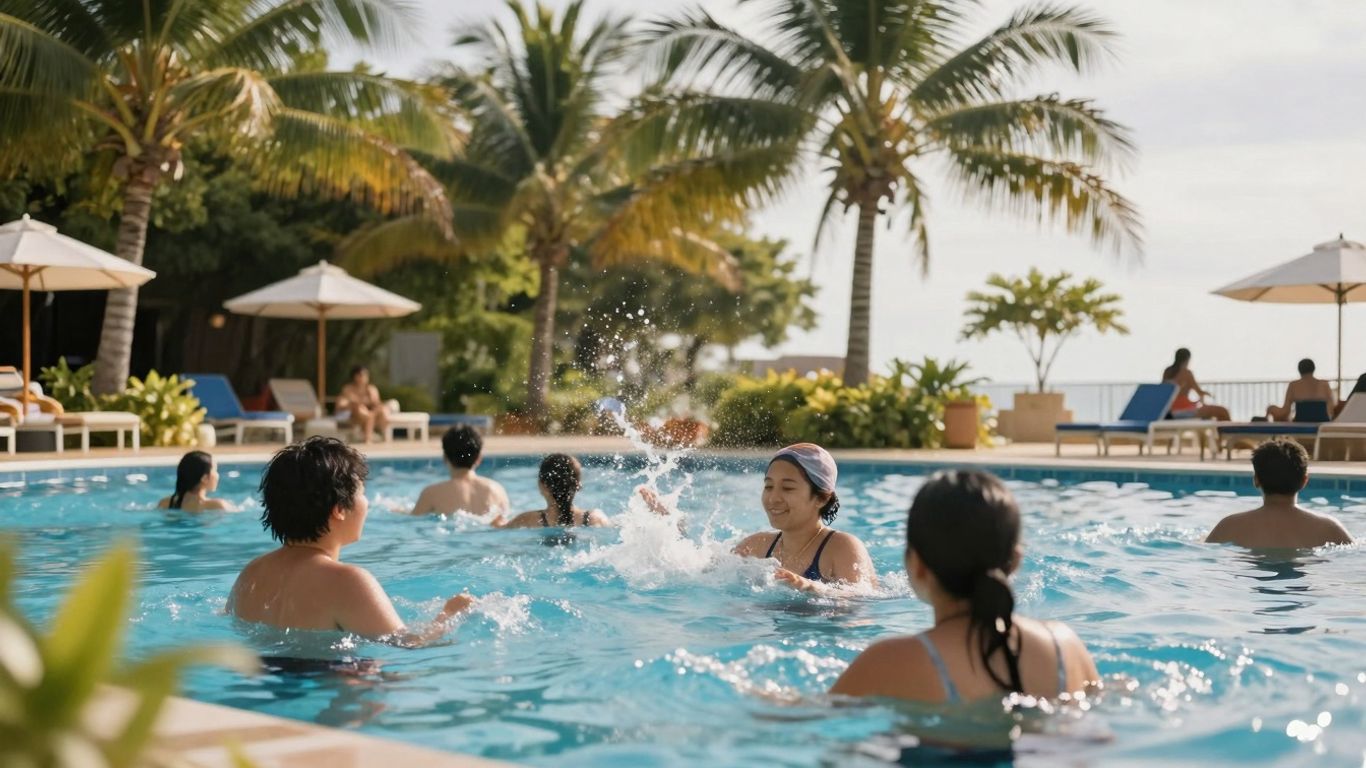Alright, so you’ve got a pool, right? And sometimes, it just doesn’t look as sparkly as it should. Maybe it’s a bit cloudy, or worse, it’s starting to look a bit green. No worries, mate! That’s where ‘swimming pool shock’ comes in. It’s basically a big dose of chemicals that cleans up your pool water and gets it back to looking its best. This guide will walk you through everything you need to know about shocking your Aussie pool, from what it is to how to do it safely and what to avoid. Let’s get that water crystal clear!
Key Takeaways
- Swimming pool shock is a strong chemical treatment used to clean up pool water, especially when it’s looking a bit off-colour or cloudy.
- There are different types of swimming pool shock, and picking the right one depends on your pool’s needs.
- Always follow the steps for shocking your pool carefully, including prepping the water and applying the chemicals safely.
- If your pool turns green, swimming pool shock is usually the go-to solution, but the amount you need depends on how green it is.
- After shocking, it’s important to keep an eye on your water chemistry and test it regularly to make sure everything stays balanced.
Understanding Swimming Pool Shock for Aussies
What is Swimming Pool Shock?
Okay, so what exactly is pool shock? Basically, it’s a way of giving your pool a super-dose of sanitiser – usually chlorine – to quickly kill off nasties like algae, bacteria, and combined chloramines (those things that cause that chlorine smell and irritate your eyes). Think of it as a reset button for your pool water. It’s not something you do every day, but it’s important for keeping your pool sparkling and healthy. You can even get a green pool bundle to help with the process.
Why Shock Your Aussie Pool?
There are heaps of reasons why you might need to shock your pool here in Australia.
- After heavy rain: Rain can bring all sorts of contaminants into your pool, messing with the water balance.
- After a pool party: More people means more sweat, sunscreen, and other stuff that can build up and make your pool cloudy.
- If you’re struggling with algae: Shocking is a great way to knock out an algae bloom quickly.
- If your chlorine levels are consistently low: Sometimes, shocking can help to boost those levels back up.
- Just as part of regular maintenance: Even if your pool looks clean, shocking every now and then can help to prevent problems before they start.
Shocking your pool is like giving it a good scrub, even if you can’t see the dirt. It helps to keep the water clean, clear, and safe for swimming.
Types of Swimming Pool Shock
There are a few different types of pool shock available, and each has its pros and cons. Here’s a quick rundown:
- Calcium Hypochlorite (Cal Hypo): This is a common and powerful type of shock. It comes in granular form and is relatively inexpensive. However, it can raise the calcium hardness of your pool water, so you need to keep an eye on that.
- Dichloroisocyanurate (Dichlor): This is another granular shock that’s easy to use and dissolves quickly. It also contains stabiliser (cyanuric acid), which protects chlorine from sunlight. However, too much stabiliser can reduce the effectiveness of your chlorine.
- Potassium Monopersulfate (Non-Chlorine Shock): This type of shock doesn’t contain chlorine, so it won’t raise your chlorine levels. It’s good for oxidising organic contaminants and can be used more frequently than chlorine-based shocks. It’s also great for people with chlorine sensitivities.
- Liquid Chlorine (Sodium Hypochlorite): This is basically just concentrated chlorine in liquid form. It’s effective, but it can be a bit messy to handle and can raise the pH of your pool water. You might need to use pH Down Tablets to balance the water.
Choosing the right type of shock depends on your specific pool and needs. Always read the instructions carefully before using any pool chemical.
The Shocking Process: A Step-by-Step Guide
Preparing Your Pool for Shock Treatment
Alright, so you’re ready to give your pool a good shock. First things first, you can’t just chuck the chemicals in and hope for the best. You need to prep the pool. Start by giving it a good clean. Skim off any leaves, bugs, or other floating debris. Brush the walls and floor to loosen any algae or dirt that’s clinging on. Basically, you want to give the shock a clean slate to work with. This ensures the shock can focus on sanitising the water, not battling a bunch of gunk. Make sure your pool vacuuming techniques are up to scratch.
- Skim the pool surface.
- Brush the walls and floor.
- Empty the skimmer baskets.
It’s also a good idea to check your philtre. A dirty philtre will just recirculate contaminants back into the pool, undoing all your hard work. Backwash or clean your philtre as needed before you start the shocking process.
Applying the Swimming Pool Shock Safely
Okay, safety glasses on, gloves on – let’s get shocking! Always, always, always follow the instructions on the shock product. Don’t just guess the amount; too much or too little can cause problems. Generally, you’ll want to pre-dissolve granular shock in a bucket of water before adding it to the pool. This helps it distribute evenly and prevents damage to your pool surface. Pour the mixture slowly around the perimeter of the pool, paying special attention to areas with visible algae. If you’re using liquid chlorine, you can usually pour it directly into the pool water.
- Wear protective gear (gloves and eye protection).
- Pre-dissolve granular shock in a bucket of water.
- Pour the mixture slowly around the pool perimeter.
Post-Shock Pool Care and Maintenance
Right, you’ve shocked the pool – job done, right? Not quite. Now comes the waiting game. Let the shock do its thing for at least 8 hours, preferably overnight. Keep the pump running to circulate the water and help the shock distribute evenly. After the waiting period, test your water chemistry. You’re looking for a chlorine level between 1 and 3 ppm and a pH level between 7.2 and 7.8. If your chlorine levels are too high, wait longer before swimming. If they’re too low, you might need to add more shock. Once your water chemistry is balanced, you’re good to go! Remember to maintain your chlorinator for optimal performance.
| Parameter | Ideal Range | Action if Outside Range |
|---|---|---|
| Chlorine (ppm) | 1-3 | Wait longer or add more shock |
| pH | 7.2-7.8 | Adjust with pH increaser or decreaser |
Tackling Green Pools with Swimming Pool Shock
Green pool? Crikey, that’s never a good sight! But don’t stress, shocking your pool can usually sort it out. The key is to figure out how bad the green is and then hit it with the right treatment. Let’s get your pool back to sparkling blue.
Identifying the Shade of Green
First things first, what kind of green are we talking? Is it a light, murky green, a dark, swampy green, or something in between? The colour tells you how much algae you’re dealing with. A light green usually means a recent algae bloom, while a dark green suggests it’s been brewing for a while. Knowing the shade helps you decide how much swimming pool shock to use.
Light Green Pool Water Solutions
If your pool is only slightly green, you’re in luck! It’s usually a pretty easy fix. The main thing is to shock the pool to kill off the algae. But before you do that, check your pH levels. Algae loves high pH, and chlorine isn’t as effective when the pH is out of whack. You’ll probably need to lower the pH using some hydrochloric acid. Add it slowly, especially if you have a vinyl-lined pool, as they’re more sensitive to harsh chemicals.
Here’s a basic plan:
- Test and adjust pH levels to the ideal range (usually around 7.2-7.6).
- Add a good dose of pool shock (follow the product instructions).
- Run your philtre for at least 24 hours.
Remember to always add chemicals to water, not the other way around. And wear gloves and eye protection – safety first, mate!
Heavy Green Pool Recovery
Right, so you’ve got a proper green swamp on your hands? This will take a bit more elbow grease. A really green pool means a lot of algae, and possibly some stagnant debris at the bottom. You might even have a few critters that didn’t make it out (yuck!).
Here’s what you need to do:
- Clear out any debris with a leaf shovel. Get rid of all the leaves and muck at the bottom.
- Test and adjust your pH and alkalinity levels. Seriously, don’t skip this step.
- Give it a massive shock treatment. You’ll probably need to use a triple dose of shock, maybe even more.
It might take a few days, or even a couple of weeks, of filtering and backwashing to get it crystal clear again. Be patient, and keep testing the water. You might need to add more shock every few days until the algae is completely gone. Don’t forget to regularly test your pool water to keep algae from growing back.
Maintaining Optimal Water Chemistry After Shocking

Balancing pH Levels for Effective Shocking
Alright, so you’ve shocked your pool – good on ya! But the job’s not quite done. Getting your pH levels right is super important for the shock to actually work properly. Think of it like this: if your pH is out of whack, the chlorine in the shock won’t be as effective at killing off all the nasties. Aim for a pH between 7.2 and 7.8. Too high, and the chlorine’s sluggish; too low, and it can corrode your pool gear. You can use a pH increaser/decreaser to adjust the levels.
Monitoring Chlorine Levels Post-Treatment
After shocking, your chlorine levels will be sky-high. You need to let them come back down to a safe swimming level before anyone takes a dip. This usually takes anywhere from 24 to 72 hours, depending on how much shock you used and how sunny it is. Sunlight burns off chlorine, so a bright day will speed things up. Use a pool test kit to keep an eye on the chlorine. You’re aiming for a level between 1 and 3 ppm (parts per million) before you let anyone back in. Remember, it’s always better to be safe than sorry!
Regular Water Testing for a Healthy Pool
Look, shocking your pool is a bit like giving it a good scrub, but it’s not a one-off thing. To keep your pool sparkling and healthy, you need to test the water regularly – at least once a week, maybe more if you’re using the pool a lot. This helps you catch any problems early before they turn into big, green, algae-filled nightmares. Test for pH, chlorine, alkalinity, and calcium hardness.
Here’s a basic guide:
- pH: 7.2 – 7.8
- Chlorine: 1 – 3 ppm
- Alkalinity: 80 – 120 ppm
- Calcium Hardness: 200 – 400 ppm
Regular testing and adjustment of your pool’s water chemistry is the key to a happy, healthy, and swimmable pool. Don’t skip this step, or you’ll be back to square one before you know it. Investing in a good pool test kit is worth it in the long run.
Common Mistakes to Avoid When Shocking Your Pool
Incorrect Dosage and Its Consequences
Getting the dosage wrong when shocking your pool is a pretty common stuff-up, and it can lead to a few different dramas. Under-shocking? You’re basically just feeding the algae a light snack, and it’ll bounce back stronger than ever. Over-shocking? You could end up with irritated skin and eyes, faded swimwear, and even damage to your pool equipment. Always read the instructions on your pool shock product carefully and measure accurately.
| Dosage Issue | Consequence |
|---|---|
| Under-shocking | Algae blooms, bacteria growth, ineffective sanitisation |
| Over-shocking | Skin/eye irritation, equipment damage, faded swimwear |
Ignoring Water Chemistry Before Shocking
Before you even think about chucking in that shock, you’ve gotta check your water chemistry. It’s like trying to bake a cake without checking if you have eggs – it’s just not gonna work. pH and alkalinity levels need to be in the right range for the shock to do its job properly. If your pH is too high, the chlorine in the shock won’t be as effective at killing nasties. Get yourself a decent testing kit and make sure everything’s balanced before you shock.
Ignoring your pool’s water chemistry before shocking is like trying to fix a leaky tap with duct tape – it might seem like a quick fix, but it’s just a band-aid solution that’ll cause bigger problems down the track.
Shocking at the Wrong Time of Day
Timing is everything, mate. Shocking your pool in the middle of a hot, sunny day is basically throwing money down the drain. The sun’s UV rays will break down the chlorine super quickly, meaning you won’t get the full sanitising effect. The best time to shock your pool is in the evening, after the sun’s gone down. This gives the chlorine plenty of time to work its magic overnight. Also, remember to run your pool pump for at least 8 hours after shocking to circulate the chemicals properly.
Here’s a few things to keep in mind:
- Always shock at night.
- Run the pump overnight.
- Test the water the next day before swimming.
Safety First: Handling Swimming Pool Shock Chemicals

Protective Gear and Safe Handling Practises
Okay, so you’re ready to shock your pool. Good on ya! But before you even think about opening that container of pool shock, let’s talk safety. This stuff isn’t cordial; it’s powerful chemicals, and you need to treat it with respect. Always wear protective gear.
Here’s the rundown:
- Safety Glasses: Protect your eyes from splashes. Seriously, you don’t want this stuff in your eyes.
- Gloves: Chemical-resistant gloves are a must. Protect your skin from direct contact.
- Old Clothes: Wear something you don’t mind getting ruined. Spills happen, and bleach stains are forever.
- Closed-Toe Shoes: No thongs! Protect your feet from spills.
When handling the chemicals:
- Read the Label: I know, it’s boring, but it’s important. Understand the instructions and warnings.
- Add Chemical to Water, Not the Other Way Around: Always add the shock to a bucket of water, never the other way around. This prevents concentrated reactions.
- Mix Outdoors: Do all your mixing in a well-ventilated area. You don’t want to be breathing in those fumes.
- Avoid Mixing Chemicals: Never, ever mix different pool chemicals together. This can create dangerous gases or even explosions.
Proper Storage of Pool Chemicals
Alright, you’ve shocked the pool, and now you’ve got leftover chemicals. Don’t just chuck them in the shed and forget about them. Proper storage is key to preventing accidents and keeping your chemicals effective. Here’s the drill:
- Keep Chemicals in Original Containers: Don’t transfer chemicals to other containers. The original container is designed for that specific chemical.
- Store in a Cool, Dry, Well-Ventilated Place: Avoid direct sunlight and extreme temperatures. A garden shed is usually fine, but make sure it’s not damp.
- Keep Away from Children and Pets: This is a no-brainer. Store chemicals in a locked cabinet or out of reach.
- Separate Incompatible Chemicals: Don’t store different types of chemicals next to each other. For example, store chlorine products away from acid products.
Emergency Procedures for Chemical Exposure
Even if you’re careful, accidents can happen. Knowing what to do in case of chemical exposure can make a big difference. Here’s a quick guide:
- Skin Contact: Rinse the affected area with plenty of water for at least 15 minutes. Remove any contaminated clothing. If irritation persists, seek medical attention.
- Eye Contact: Flush the eye with water for at least 15 minutes. Seek immediate medical attention.
- Inhalation: Get to fresh air immediately. If breathing is difficult, seek medical attention.
- Ingestion: Do not induce vomiting. Drink plenty of water. Seek immediate medical attention. Call the Poisons Information Centre on 13 11 26.
Remember, prevention is always better than cure. Take your time, be careful, and always follow the instructions on the label. Your safety, and the safety of those around you, is the most important thing.
And remember, after shocking, a pool vacuum is your best mate for clearing up any settled debris. Keep that pool sparkling!
When to Call in the Pool Professionals
Let’s be honest, sometimes DIY just doesn’t cut it. While shocking your pool is usually straightforward, there are times when calling in a professional is the smartest move. It can save you money in the long run by preventing further damage or misdiagnosis. Plus, they’ve got the gear and the know-how to tackle tricky situations.
Persistent Algae Issues
So, you’ve shocked your pool, scrubbed the walls, and vacuumed like a madman, but that green tinge just won’t budge? Persistent algae blooms, especially black or mustard algae, can be a real pain. These types are resistant to standard chlorine levels and often require specialised treatments that a pool professional is best equipped to handle. They can accurately identify the type of algae and apply the correct chemicals in the right concentrations. It’s also worth considering that recurring algae might point to an underlying issue with your pool’s circulation or filtration system.
Complex Water Chemistry Problems
Is your water chemistry reading like a science experiment gone wrong? Are you constantly chasing pH, alkalinity, and calcium hardness levels without any lasting success? It might be time to throw in the towel and get a professional water test done. They can identify hidden imbalances or issues with your pool equipment that are affecting your water quality. Trying to fix complex water chemistry without the right knowledge can lead to damage to your pool’s surface and equipment, not to mention making the water unpleasant to swim in. A professional can perform a comprehensive analysis and recommend a tailored treatment plan to get your pool back on track. They can also help you understand how to maintain optimal water chemistry going forward.
Professional Advice for Your Pool
Not sure where to start with pool maintenance, or just want a second opinion? A pool professional can provide expert advice on everything from choosing the right chemicals to optimising your filtration system. They can also help you develop a regular maintenance schedule to keep your pool sparkling clean and healthy all year round. Think of it as an investment in the longevity of your pool and the enjoyment of your swimming season. Plus, they can spot potential problems early on, preventing costly repairs down the line.
Getting professional advice doesn’t have to be a sign of failure. It’s about being proactive and ensuring your pool is in the best possible condition. A good pool technician can become a trusted partner in your pool care journey.
Wrapping It Up: Keep Your Pool Sparkling
So, there you have it. Giving your pool a good shock isn’t just about throwing chemicals in; it’s about keeping things clean and safe for everyone. It might seem a bit much at first, all those steps and numbers, but once you get the hang of it, it’s pretty straightforward. Just remember to test your water regularly, pick the right stuff, and follow the directions. Do that, and you’ll have a pool that’s always ready for a swim, no worries. A bit of effort now means a lot more fun later, and who doesn’t want that?
Frequently Asked Questions
What exactly is ‘pool shock’?
Pool shock is a strong dose of chemicals, usually chlorine, that you add to your pool water. It’s much stronger than your regular daily dose. The idea is to quickly kill off nasty stuff like algae, bacteria, and other yucky bits that can make your pool cloudy or green. Think of it like a big clean-up crew for your pool.
Why do I need to shock my pool, mate?
You should shock your pool regularly, especially after heavy use, a big storm, or if the water starts looking a bit off, like cloudy or green. It helps keep the water super clean and safe for swimming by getting rid of all those tiny things that can cause problems. It’s like giving your pool a good scrub to keep it sparkling.
What different kinds of pool shock are there?
There are a few types, but the main ones are chlorine-based. You’ve got calcium hypochlorite (cal-hypo), which is a common choice, and then there’s dichlor and lithium hypochlorite. Each one works a bit differently, but they all aim to give your pool a powerful clean. Make sure you pick the right one for your pool type.
When’s the best time of day to shock my pool?
It’s best to shock your pool in the evening or at night. The sun’s UV rays can break down the chemicals too quickly, making the shock less effective. By doing it when the sun’s down, the chemicals have more time to work their magic and clean the water properly.
How long do I have to wait after shocking before I can swim?
After shocking, you need to wait until the chlorine levels in your pool drop back down to a safe level for swimming. This usually takes a few hours, but it can be longer depending on how much shock you used and your pool’s size. Always test the water before jumping in to make sure it’s safe.
My pool is still green after shocking, what’s the go?
If your pool is still green after shocking, it usually means the algae problem was a bit tougher than you thought, or you might not have used enough shock. You might need to do another shock treatment, or check your water’s pH and other levels, as they can affect how well the shock works. Sometimes, a really stubborn green pool needs a bit more effort.





